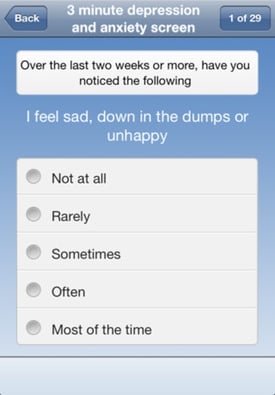
Between games of Angry Birds and Words With Friends, developers of a new smartphone app are hoping you’ll take a moment to check up on your mental health.
The app, called WhatsMyM3, screens for four different mental disorders—depression, anxiety, bipolar disorder, and post-traumatic stress disorder (PTSD)—with a three-minute, 27-question survey.
The questionnaire asks users to gauge their emotional state over the past two weeks by rating how often a series of statements rang true for them. The statements (“Nothing seems to give me much pleasure,” for example, or “I can’t get certain thoughts out of my mind”) cover a variety of mood-related factors, among them, energy level, appetite, ability to concentrate, and thoughts of suicide. The scale of responses ranges from “not at all” to “most of the time.”
WhatsMyM3 assembles these rankings and comes up with a number to help users decide whether they should seek professional help. A score above 33 throws up a red flag that something might be wrong.
And if users indicate they have even “rarely” considered suicide, the program prompts them to take advantage of a 24-hour crisis hotline.
Michael Byer, president of M3 Information—the company that developed the app—says using a number to track mental health can help patients take control of their psychiatric care.
“The brain has never had a number like all the other diseases have,” he says. He points out that scores for cholesterol, blood pressure, and heart rate already help patients keep tabs on their physical wellbeing.
And because smartphone apps are accessible and easy to use, he says, WhatsMyM3 might tip more people off to a potential mental illness while it’s still in its early stages.
Dr. Steven Daviss, chair of psychiatry at Baltimore Washington Medical Center, associate professor at the University of Maryland’s School of Medicine, and chief information officer for M3 Information, says the test’s straightforwardness was what appealed to him.
“What I was really struck by was this simple notion, which at first made me skeptical,” he says. “I thought, ‘You can’t put everything down into one number—it’s much more complicated than that.’ And of course it is, but this is a screening test,” he says.
Patrick Hendry, senior director of advocacy for Alexandria-based Mental Health America, says an early screen could have helped him avoid a struggle with bipolar disorder that had him in and out of hospitals 14 times in seven years before reaching an accurate diagnosis.
“A lot of times, people will be feeling down or stressed out or anxious, but they won’t necessarily think they have a mental problem,” Hendry says. “They often think, ‘I’m down, but it will go away.’”
That’s where the screen could actually be most useful, Byer says. He and Daviss envision taking the test beyond the smartphone and into the doctor’s office, where they say patients coming in for an annual checkup could fill out the survey while waiting for their appointment.
Dr. Daniel Z. Lieberman, a professor of psychiatry and behavioral sciences at George Washington University who specializes in mood disorders and technology, says the WhatsMyM3 survey will be most useful to those primary care physicians, both in recognizing new mental disorders in a patient and in tracking disorders that are already on the radar.
“[A primary care physician] is also managing the high blood pressure and the joint pain and the insomnia,” Lieberman says. While psychiatrists have the time to delve into what’s going on in a patient’s life, Lieberman says for a primary care doctor, “it’s more, ‘How’s your mood been since we started the medication?’”
M3 Information is working on ways to help patients share their results with a doctor; an option to e-mail results from the app is one feature they’ve discussed, Daviss said. A Spanish version of the app is also available.
What’sMyM3 is available for download for iPhone and Android for $2.99. Or take the questionnaire for free online at WhatsMyM3.com.


















